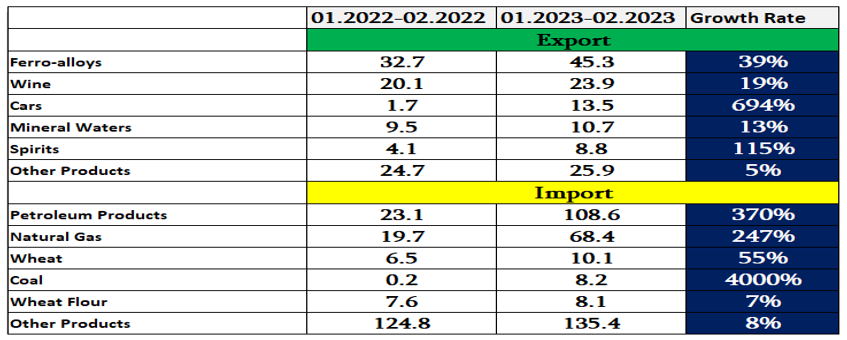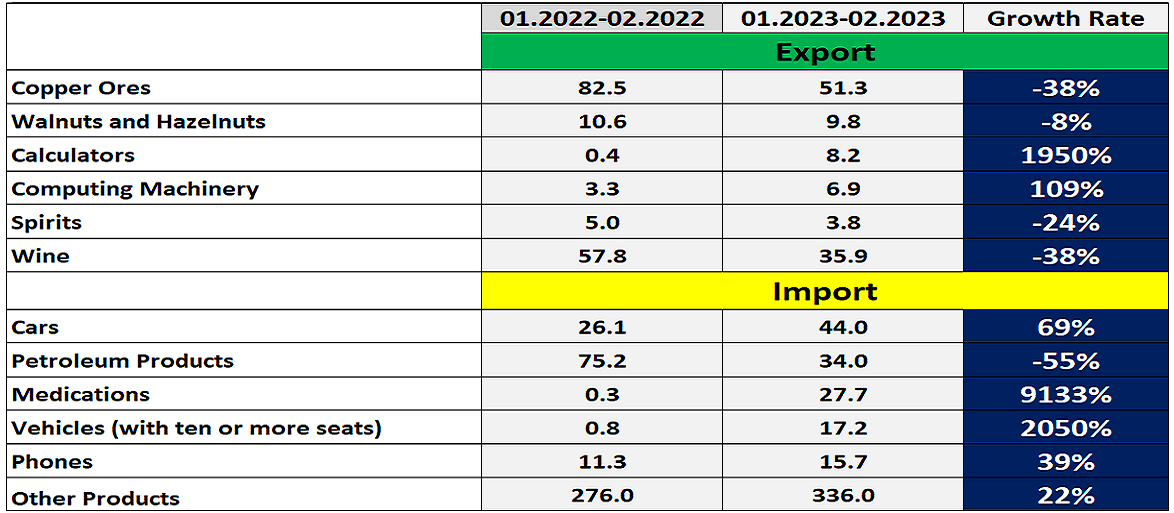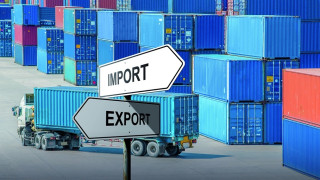In January-February 2023, Georgia’s trade turnover with EU member states increased by 8% as compared to the same period of the previous year from USD 549 million to USD 591 million whilst trade with Russia rose by 70% from USD 275 million to USD 467 million.
At the beginning of 2023, the foreign trade turnover increased with most of the countries, although the growth rate was different vis-à-vis different countries or group of countries. As a result of a 192% growth, Armenia became the top exporter. This position was occupied by Russia and China in the previous years. At the same time, Russia outperformed Turkey both in terms of imports and total trade turnover with an 86% growth rate.
Graph 1: Trade Turnover Change Dynamic in January-February 2022-2023

Source: National Statistics Office of Georgia
After Russia’s invasion of Ukraine, the trade turnover structure has been drastically changed almost everywhere in the world. Given higher prices on energy carriers, the European Union initially also increased imports (in monetary value) from Russia; however, imports from Russia were slashed after peak prices subsided and alternatives were found.
Georgia did not join the sanctions, although committed not to breach them. International sanctions mostly limit the export of military and dual-use products to Georgia of which the country produces very little. Despite multiple allegations in the Georgian and the international media, there was not a confirmed fact of breaching the sanctions over the course of the last 13 months.
In January-February 2023, export from Georgia to Russia increased by 38% from USD 93 million to USD 133 million and the growth of import was much larger – by 86% from USD 275 million to USD 467 million – as compared to the same period of the previous year (period before the outbreak of war).
Table 1: Trade Turnover with Russia

Source: National Statistics Office of Georgia
Cars comprise the largest growth among export items. This is, however, re-export. The demand for cars shipped through Georgia has increased as a result of the tensions between Russia and the West. In January-February 2022, a total of 209 cars were sent to Russia for re-export whilst this number was 978 in the same period of 2023. This cannot be considered as a breach of sanctions because the restriction is only applied to those cars which cost EUR 50,000 (USD 54,000) and more.
The situation is different in terms of imports. As a result of the sanctions, Russia has to sell its energy carriers cheaper than the others. This fact allows Georgian importers to impose a more competitive price and increase their margin of profit.
The 4,000% growth of coal import when considering the base period does not mean much. The situation is more interesting in terms of the car fuel and the natural gas markets. According to the information of the National Statistics Office of Georgia, the share of import of Russian petroleum products in terms of monetary value exceeded 68% (from USD 109 million to 158 million) and by 85% (149,000 tonnes out of 174,000) in terms of volume. The share of Russian natural gas import has also increased to 39% (from USD 68 million to USD 176 million). This is entirely commercial gas. The population and the country’s thermal power plants use only Azerbaijani gas whilst businesses use only a portion of Azerbaijani gas.
Despite the 38% drop, copper ores still rank the first among export items to the EU. However, petroleum products were replaced with cars in terms of top import items. In some cases, a four-digit percentage growth is because of the base period.
Table 2: Trade Turnover with the EU

Source: National Statistical Office of Georgia
Georgia signed the Association Agreement with the EU on 27 June 2014 which means that Georgian products are now allowed on the world’s second largest market, after the USA, without customs levies. Nevertheless, export to the EU has increased by only 42% from 2013. If we add the UK in light of the free trade agreement with Georgia which was launched again, the growth will be 45%. Georgia’s total export increased by 95% in the same period because of the re-opening of the Russian market as well as the free trade agreement with China from 2018. Neither Russia nor China has trade requirements similar to the EU, although the political risks are incomparably higher in the case of Russia.
Generally, two months is a rather limited period of time and there is a significant chance that this picture will change in the next six months. However, this period is important because of Russia’s invasion of Ukraine on 24 February 2022 which sparked serious changes across the planet, in general, and in this region, in particular. As early as from March 2023, the economic data will have to be compared to the period after the war is over.







